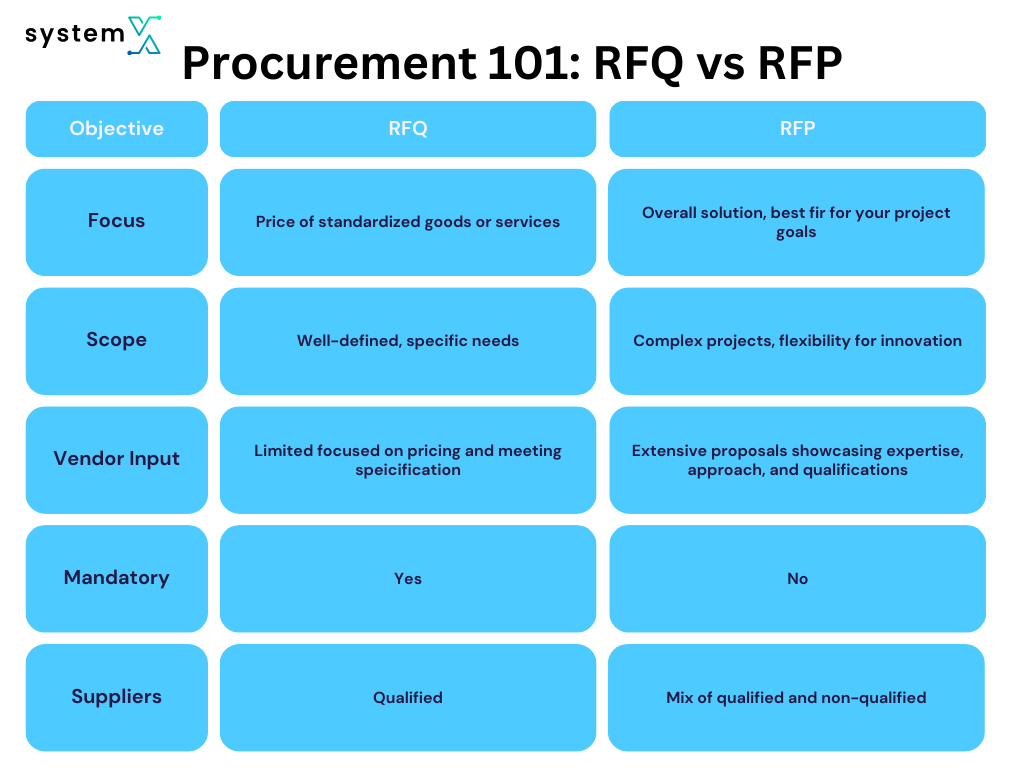Picture this: you’re browsing for the perfect pair of headphones – noise-canceling, comfortable, great sound quality. You compare specs, read user reviews, and carefully weigh prices. That same decision-making process happens in the business world, just a bit more structured.
Companies use tools like an RFP (Request for Proposal) and an RFQ (Request for Quotation) to source the right products or services. These documents are like the ‘specs and reviews’ for businesses, ensuring they make informed choices.

Let’s break down the world of RFQs – what they are, the process of sending them, and how they differ from RFP’s
What is an RFQ
A Request for Quotation (RFQ) is a formal business document used in procurement to solicit price quotes from potential suppliers for well-defined products or services. RFQs typically include detailed specifications, quantity requirements, delivery timelines, and any relevant terms and conditions. The primary focus of an RFQ is to obtain competitive pricing for standardized goods or services.
RFQ’s provide a structured way to obtain pricing information for well-defined products or services. It includes precise specifications, quantities, delivery expectations, and relevant terms and conditions.
If you’re confident in the specific requirements, prioritize cost comparisons, and don’t anticipate the need for ongoing support or complex contracts, an RFQ is a suitable tool. RFQs enable you to streamline the vendor selection process by facilitating rapid price-based evaluations.
When Should you Use an RFQ
An RFQ is best suited for situations where you need to purchase standardized products or services with clearly defined specifications. If your primary concern is finding the best price and you have a predetermined budget, an RFQ can streamline the procurement process.
Use an RFQ when you know exactly what you need, don’t require significant vendor input or customization, and need to make a time-sensitive purchase decision.
In fact, Approximately 70% of businesses use RFQs when they have a clear understanding of their needs
Here are some specific examples when an RFQ would be appropriate:
- Purchasing bulk office supplies: Pens, printer paper, etc.
- Procuring standard software licenses: Operating systems, productivity tools.
- Hiring routine maintenance services: Landscaping, janitorial services.
- Ordering replacement parts with exact specifications: Machinery components, hardware.
6 Steps to Crafting and Sending Out a Successful RFQ
- Define Your Exact Needs: RFQs excel with precise specifications. Know exactly what you need, including quantities, quality standards, and any non-negotiable features.
- Definition of the products or services required with detailed specifications
- Delivery requirements
- Quantities
- Payment terms
- The proposed method of evaluation
- Decision timeline and review process
- Contract terms and conditions
- Submission requirements
- Price Matters Most: Be clear that your primary decision factor is cost. This tells vendors to focus on competitive pricing rather than extensive proposals.
- Draft the Document: Include clear specifications, delivery timelines, payment terms, and submission instructions.
- Target the Right Vendors: Focus on suppliers with a proven track record of providing the specific goods or services you need.
- Streamline Comparison: Request pricing in a standardized format, making it easy to compare quotes side-by-side.
- Choose Based on Price (But Not Only): While the lowest price is important, also consider factors like delivery reliability and vendor reputation to ensure the best overall value.
Now, let’s explore how an RFP (Request for Proposal) differs and when it might be a better fit for your procurement needs.
What is an RFP
An RFP (Request for Proposal) is a formal document used in procurement to solicit comprehensive proposals from potential vendors. In contrast to an RFQ (Request for Quotation), which focuses on pricing for defined needs, an RFP seeks solutions. It outlines a company’s project goals, challenges, and desired outcomes, inviting vendors to propose their approach, expertise, and qualifications to achieve those goals.
RFPs invite comprehensive solutions from potential vendors. They outline a company’s project goals, challenges, and desired outcomes. RFPs allow vendors to showcase their unique approaches, expertise, and qualifications. Companies use RFPs when they need tailored solutions, value innovation, and prioritize strategic partnerships, often for complex or long-term projects.
If you are open to exploring different solutions, want to assess vendor capabilities beyond cost, and may require ongoing support or customized agreements, an RFP is the right way to go. RFPs give you the flexibility to evaluate proposals based on expertise, innovation, and the overall fit for your specific needs.
When Should you Use an RFP
An RFP is best suited for situations where you need a customized solution, want to explore different approaches, and prioritize finding the best overall fit for your project. If you are open to innovation and strategic partnerships, an RFP allows for a comprehensive evaluation beyond just price.
Use an RFP when you need to solve complex problems, have flexibility in your budget, or are looking to implement new technologies or processes.
According to openasset, Approximately 45% of businesses believe that RFPs facilitate a more detailed evaluation of potential vendors.
Here are some specific examples when an RFP would be appropriate:
- Website Redesign/Development: Seeking proposals outlining design concepts, content management systems, and user experience strategies.
- Marketing Campaign Development: Inviting agencies to present creative approaches, audience targeting, and measurement plans.
- Custom Software Development: Soliciting proposals detailing technology choices, development methodologies, and project timelines.
- Business Process Improvement: Seeking consulting firms to provide tailored strategies, change management support, and ongoing optimization.
RFQ vs RFP: Key Differences
RFQs and RFPs are both valuable procurement tools, but they differ significantly in their focus and application. An RFQ is primarily concerned with obtaining the best price for standardized, well-defined products or services.
Companies use RFQs when they have a clear understanding of their exact requirements and prioritize cost comparisons. In contrast, an RFP seeks a comprehensive solution tailored to a company’s unique needs. RFPs are ideal for complex projects where factors beyond price are critical, such as innovation, vendor expertise, and strategic alignment with the company’s goals.

- Focus:
- RFQ: Price of standardized goods or services
- RFP: Overall solution, best fit for project goals
- Scope:
- RFQ: Well-defined, specific needs
- RFP: Complex projects, flexibility for innovation
- Vendor Input:
- RFQ: Limited, focused on pricing and meeting specifications
- RFP: Extensive proposals showcasing expertise, approach, and qualifications
- Decision Factors
- RFQ: Primarily cost-driven
- RFP: Price, quality, innovation, vendor fit, and strategic alignment
Know your Business Needs
Choosing between an RFQ and RFP depends entirely on your specific procurement goals. RFQs streamline the process for standardized goods or services where price is paramount. RFPs offer a deeper dive for complex projects, prioritizing innovative solutions and the best overall strategic fit. Understanding the nuances between these tools empowers you to make informed sourcing decisions, ensuring you find the right products, services, and partnerships to enhance your business operations.
FAQ
I’m still not sure whether to use an RFQ or an RFP. What should I do?
Ask yourself these questions:
- Do I know exactly what I need? If yes, an RFQ might be sufficient. If you’re unsure about the best solution, an RFP is likely better.
- Is price my absolute top priority? If so, an RFQ is a good choice. If other factors (innovation, expertise, etc.) are equally important, consider an RFP.
- Am I open to different approaches? An RFP invites a wider range of solutions, while an RFQ is more focused on fulfilling specific requirements.
Can I send both an RFQ and an RFP for the same project?
While technically possible, it’s usually not advisable. Sending both can confuse vendors and create more work for your team. It’s best to determine your primary goal (price vs. tailored solution) first. However, in some cases, you might issue an RFQ to narrow down a large pool of potential suppliers and then use an RFP with the shortlisted vendors for a more in-depth evaluation.
What are some common mistakes to avoid when using RFQs and RFPs?
Here are a few pitfalls:
- Unclear Requirements: Be as specific as possible to get accurate responses.
- Overly Restrictive Formats: Leave some flexibility for vendors to demonstrate their strengths.
- Neglecting Evaluation Criteria: Develop a clear scoring system before issuing the RFQ/RFP to ensure objective comparisons.

